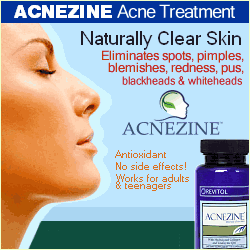Acne Advice For People Wanting Blemish Free Skin
Acne is a disorder of the skin that affects adults as well as teens. It occurs when follicles, or pores, become blocked. Oils, naturally present in skin, are unable to drain and become blocked inside the follicles. Before long bacteria begins to grow.
Skin blemishes referred to as blackheads and whiteheads then begin to appear. When the oil and bacteria that is trapped remain below the skin, the blemish is referred to as a whitehead. A blackhead occurs when the oil and bacteria are partially exposed. The color of the blemish turns black due to pigmentation within the skin. Blackheads usually last far longer than whiteheads due to the fact that it takes longer to drain.
It is believed that hormones, diet, stress and vitamin deficiency may play a role in the development of acne. While acne includes both whiteheads and blackheads, there are a variety of types of acne that range in severity.
Acne Vulgaris is the most common form of acne and includes everything from whiteheads and blackheads to cysts. Acne Vulgaris may be either mild or moderate as well as severe. The mild and moderate forms of Acne Vulgaris include common pimples with inflammation apparent below the surface of the skin as well as blackheads. Small red bumps that have no ‘head’ may also be present and are known as papules.
Acne Vulgaris in its most severe form includes lesions that are known as nodules and cysts. These are normally much larger than mild or moderate acne and may be more painful. Nodules are usually small and hard, below the skin and do not contain pus while cysts do. Scars can appear if Acne Vulgaris is not treated correctly.
A gentle cleanser and a benzoyl peroxide cream can be effective in treating mild to moderate forms of Acne Vulgaris. Avoid overwashing; gently cleansing the face in the morning and at night should be sufficient. Taking care not to touch your face during the day and using oil free cosmetics may also help. Extreme caution should be used in trying to ‘pop’ pimples, as this can result in scarring. Papules (small red bumps with no head) should never be popped or squeezed.
Acne Rosacea can easily be confused with Acne Vulgaris and often appears to be quite similar. Most people who suffer from Acne Rosacea are adults over the age of 30. A red rash along with bumps and pimples signal the presence of Acne Rosacea, which normally appears on cheeks, nose, forehead and chin. Blackheads are normally not present with Acne Rosacea. This type of acne can be quite serious because when it is left untreated it can actually cause excessive tissue to begin growing.
There are three types of extremely severe acne; all of which can be disfiguring. Acne Conglobata usually appears in men instead of women. It is commonly found on the trunk and limbs of the body instead of the face. Individuals normally develop this form of acne at some point between the ages of 18 and 30. It can remain active for several years and can be extremely difficult to treat. Dermatologists normally use Accutane as a treatment.
Young men sometimes experience what is known as Acne Fulminans. Typical acne may be accompanied by fever and aching joints with the onset of Acne Fulminans. Oral steroids as well as Accutane may be used to treat this form of acne.
Women between the ages of 20 and 40 may experience what is known as Pyoderma Faciale. This type of acne is generally confined to the face. Unlike other forms of acne, this form does not last for years; instead its presence is normally restricted to a year or less. It can, however; be very painful as well as disfiguring.
Click here for detail












0 comments:
Post a Comment